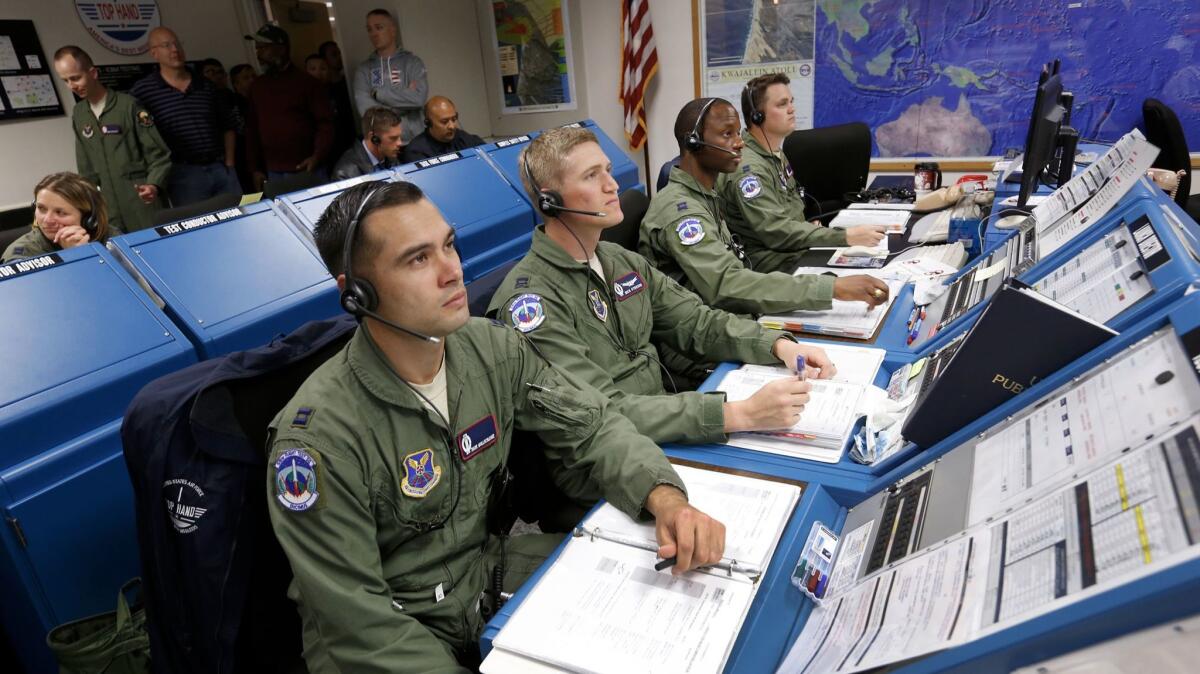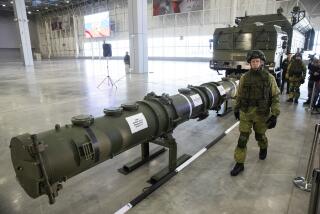Upgrading U.S. nuclear missiles, as Russia and China modernize, would cost $85 billion. Is it time to quit the ICBM race?

An unarmed intercontinental ballistic missile (ICBM) was launched from Vandenburg Air Force base in California just seven days after the first launch. (Al Seib / Los Angeles Times)
Reporting from Vandenberg Air Force Base — The sky over the turbulent Pacific was pitch-black earlier this month when a Minuteman III missile blasted off from Vandenberg Air Force Base on a column of fire that illuminated the California coastline for miles.
The unarmed missile thundered past the outer reaches of the atmosphere, tracing a fiery arc around the globe before plunging into a lagoon at Kwajalein Atoll in the South Pacific, 4,200 miles away.
The Minuteman III tested May 3 near Lompoc is a critical element of U.S. defense strategy: a fleet of intercontinental ballistic missiles capable of obliterating any spot on Earth with a nuclear blast in 30 minutes or less.
Although the flight test proved Minuteman is still capable of performing its mission, major components of the missile and the control centers used to launch them are Cold War-era relics that have become increasingly expensive to maintain. Spare parts are in such short supply that the military has been known to pull them from museums.
At the same time, Russia and China are upgrading their nuclear capabilities. Pakistan, India and Israel continue to build new nuclear weapons and delivery systems. Air Force officials worry increasingly about the Minuteman’s ability to penetrate adversaries’ future missile defense systems.
The result is one of the most strategically complex and financially difficult challenges the Trump administration faces in making good on the president’s pledge for a “great rebuilding of the armed forces,” including the nation’s aging nuclear arsenal.
The Pentagon has begun work to replace the Minuteman fleet with a new generation of missiles and launch control centers, but the plan would cost an astronomical $85 billion, one of the most expensive projects in Air Force history.
Two defense firms will be awarded three-year contracts for $359 million each this year, with a test flight program scheduled for launch in the mid-2020s.
The tremendous expense of deploying a missile fleet capable in the long term of countering nuclear threats has spawned a debate in the American military establishment: How essential, in the 21st century, are the 400 strategic missiles embedded in silos deep under the plains of Colorado, Nebraska, Wyoming, Montana and North Dakota?
The discussion has opened for review the very essence of the nation’s nuclear defense strategy: the “triad” deployment of nuclear weapons, in submarines, strategic bombers and land-based silos, to guarantee the ability to retaliate against any nuclear strike.

The Minuteman III was developed in the 1960s and first deployed in 1970. The nearly 50-year-old hardware is still working fine, but not without extensive maintenance.
“I look at the Minuteman III like a classic car,” said Col. Craig Ramsey, commander of the fleet’s flight test squadron at Vandenberg. “I love my 1966 Mustang, but it requires a lot of tender loving care and maintenance whether you drive it or leave it in the garage.”
At its peak in about 1990, the Air Force fielded 450 Minuteman IIs, 500 Minuteman IIIs and 50 Peacekeeper missiles, a total of 1,000 ICBMs that had more than 2,000 warheads on them. Today’s 400 Minuteman missiles each field a single warhead.
Pentagon officials want to replace almost the entire nuclear arsenal, at a cost of up to $1 trillion. But no component has raised more questions than the replacement of the ICBM fleet, which critics have said is no longer crucial to preventing a nuclear war.
The argument for eliminating ICBMs is stronger than at any time in the past. Advocates of that strategy say submarine-based missiles and strategic bombers have improved their capability and are now more than potent enough to deter an enemy attack.
Former Defense Secretary William J. Perry fired the opening salvo last year, calling for phasing out the entire land-based ICBM force. He argued that its continued deployment is too costly. And with the missiles on continuous alert in order to be able to launch instantly if an enemy launch is detected by satellites and radar, a mistake or faulty warning could trigger an accidental nuclear war.
“The ICBM system is outdated, risky and unnecessary,” Perry, who served in the Clinton administration 20 years ago, said in a recent interview. “Basically, it can bring about the end of civilization with a false alarm. It’s a liability because we can easily achieve deterrence without it.”

Perry has not been alone in expressing doubts about the ICBM program, but senior Pentagon leaders have always been persuaded to keep it. Former Defense Secretary Chuck Hagel called for elimination of ICBMs before entering office and then changed his mind. Trump’s Defense secretary, James N. Mattis, questioned the need for the missiles in 2015 when he was a four-star general. But as soon as he was nominated, he began supporting a full-blown modernization of the triad.
The reevaluation of the role of ICBMs in America’s defense comes in an era when nuclear weapons are proliferating, not fading away. GlobalSecurity.org director John Pike, who has analyzed U.S. military systems and strategies for more than three decades, says critics “are gaining no traction” in calling for the elimination of the ballistic missile fleet.
The Air Force makes the case that replacing the Minuteman will be less costly than trying to keep its Elvis-era fleet in perfect working order for decades into the future. The nation’s strategic forces represent a small slice of defense spending, while providing a large measure of security against an unprovoked attack on U.S. soil.
Air Force leaders also worry that Russia, China and North Korea are investing in new nuclear missile systems that would erode the military edge that the Minuteman has provided with its reliability and accuracy. At some point, they say, the Minuteman’s ability to penetrate future missile defense systems could be compromised.
“Nuclear weapons are foundational to our national security,” said Maj. Gen. Fred Stoss III, director of operations at the Air Force Global Strike Command. “The ICBMs are the most responsive. They have the quickest launch times. The ICBMs are the most stabilizing leg of the triad.”

Eliminating the more than 400 ICBMs and their launch capsules as targets, Stoss said, would allow an enemy to wipe out the rest of the nation’s nuclear deterrent — three strategic bomber bases and two strategic submarine bases — with just five nuclear weapons. That leaves the U.S. vulnerable to attack even from “nations with limited arsenals,” such as North Korea, Stoss said.
Failing to maintain strategic parity puts the U.S. at a disadvantage with potential adversaries, Stoss added. “Russia has a triad. China is on the cusp of a triad.”
Beyond the military arguments, there is the question of cost.
Numerous Pentagon officials and outside experts have warned that the current approach cannot be sustained without significant and sustained increases to defense spending or cuts to other military priorities. The costs for modernization would peak during the mid-2020s and overlap with large increases in projected spending on other weapons that address more immediate threats, such as counter-terrorism, cyberattacks, and space-based technology.
Two years ago, the Pentagon said the new ICBM system, known as the Ground-Based Strategic Deterrent, would cost $62.3 billion. But outside estimates put it far higher. The Pentagon’s independent office of Cost Assessment and Program Evaluation said last year the plan could cost at least $85 billion.
The costs are likely to climb because of the technological complexity of the program. By comparison, the last time the U.S. fielded a new ICBM, the massive, 10-warhead MX in the mid-1980s, the cost was an inflation-adjusted $900 million per missile. The new, smaller ICBM and its launch centers will optimistically average out to about $132 million per missile. Though the MX cost was elevated by its large size and small production numbers, just 50 deployed missiles, it saved money by using the existing launch complex.
“Unless the Defense and Energy departments find a pot of gold at the end of the rainbow or get a loan from the same man or woman who sold Jack his magic beanstalk beans, I do not believe the current spending plans are feasible,” said Kingston Reif, director for disarmament and threat reduction policy at the Arms Control Assn. in Washington. “I think the ICBM leg of the triad is by far the least valuable leg of the triad, and the effort to sustain it should reflect that.”
Col. Heath Collins, Air Force program manager for the ICBM replacement program, said a new missile program will need an all-new command-and-control system, meaning full replacement of the old analog computers that now operate the Minuteman system — and that’s only the start.
One of the biggest costs will be the guidance system, notes Aloysius G. Casey, a retired general who was the program manager for the MX missile.
The MX guidance system, which cost $10 million to $12 million per missile, had 19,401 parts packaged inside a device the size of a basketball. The device was so accurate that engineers at the time said it could detect variations in the rotation of Earth while it was on the silo, relying on mechanical gyroscopes suspended in a fluid.
Today, it would be vastly cheaper to use a GPS guidance system, Casey said. The satellite-based navigation system is used on a large range of conventional weapons systems and is a standard feature of smartphones.
But critics fear that GPS satellites could be attacked or their signals jammed or spoofed. The upshot is that any guidance system is almost sure to require a massive expenditure.
Advocates say the shocking price tags are the cost of doing business in a dangerous world currently engaged in a new technology race. There are few precedents on which to judge it, Collins said. “It is the most complex program that I’ve ever been a part of.”
Twitter: @wjhenn
Follow me on Twitter @rvartabedian
ALSO:
Climate change is real: Just ask the Pentagon
Trump administration stops disclosing troop deployments in Iraq and Syria
U.S. launches dozens of missiles at Syria in response to chemical weapons attack
More to Read
Sign up for Essential California
The most important California stories and recommendations in your inbox every morning.
You may occasionally receive promotional content from the Los Angeles Times.












